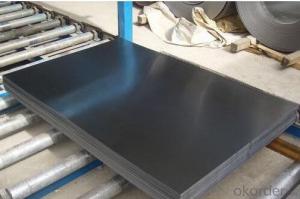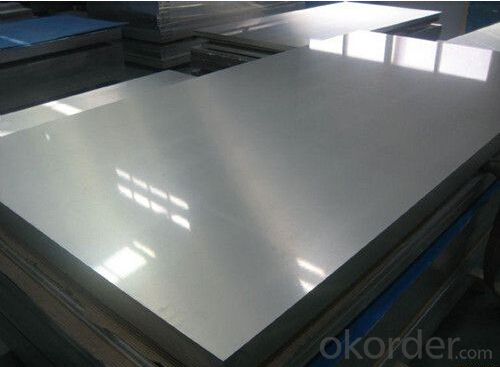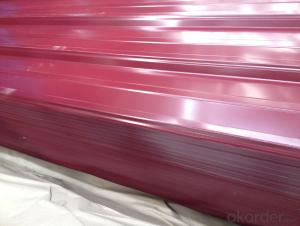Best Quality of Cold Rolled Steel Sheet from China
- Loading Port:
- Tianjin
- Payment Terms:
- TT OR LC
- Min Order Qty:
- 100 m.t.
- Supply Capability:
- 5000 m.t./month
OKorder Service Pledge
OKorder Financial Service
You Might Also Like
1.Structure of Cold Rolled Steel Description:
The raw material of cold rolled steel coil/sheet is high quality hot rolled product, and after pickling continuous rolling, degreasing, annealing,skin pass,slitting and cut to length line etc. Along with it many kinds of new technology and new process of global cold rolling production have been applied. Therefore the quality of the goods could be guaranteed. The product is widely used in outdoor and interior decoration, furnishing manufacturing, home appliance, automobile etc.
2.Main Features of the Cold Rolled Steel:
• Excellent process capability
• Smooth and flat surface
• Workability, durability
• Excellent heat resistance performance
• High strength
• Good formability
• Good visual effect
3.Cold Rolled Steel Images

4.Cold Rolled Steel Specification
Standard:AISI,ASTM,DIN,GB,JIS,JIS G3302 ASTM 653M EN10142
Grade: Q195~Q345
Thickness: 0.16mm~1.5mm,0.16-1.5mm
Width: 1250,600-1250mm
Coil weight:3-12 MT
Coil ID:508/610mm
Chemical composition:
C | Si | Mn | Cr | Ni | P | S |
0.150 | 0.476 | 11.231 | 12.50 | 0.900 | 0.039 | 0.010
|
5.FAQ of Cold Rolled Steel
We have organized several common questions for our clients,may help you sincerely:
1.How about your company?
A world class manufacturer & supplier of castings forging in carbon steel and alloy steel,is one of the large-scale professional investment casting production bases in China,consisting of both casting foundry forging and machining factory. Annually more than 8000 tons Precision casting and forging parts are exported to markets in Europe,America and Japan. OEM casting and forging service available according to customer’s requirements.
2.How to guarantee the quality of the products?
We have established the international advanced quality management system,every link from raw material to final product we have strict quality test;We resolutely put an end to unqualified products flowing into the market. At the same time, we will provide necessary follow-up service assurance.
3. How long can we receive the product after purchase?
Usually within thirty working days after receiving buyer’s advance payment or LC. We will arrange the factory manufacturing as soon as possible. The cargo readiness usually takes 15-25 days, but the shipment will depend on the vessel situation.
- Q: Can the steel sheets be used for outdoor furniture?
- Outdoor furniture can indeed utilize steel sheets. Steel, being a robust and weather-resistant substance, is well-suited for outdoor purposes. It can withstand diverse environmental conditions, including rain, wind, and sunlight, without rapid corrosion or deterioration. Moreover, steel sheets can be manipulated and formed into various furniture styles, offering both practicality and visual allure. Whether it's tables, chairs, benches, or even decorative accents, steel sheets prove to be an exceptional option for outdoor furniture due to their durability, longevity, and adaptability.
- Q: Are the steel sheets resistant to bending or warping?
- Yes, steel sheets are highly resistant to bending or warping. Steel is known for its strength and durability, making it a popular choice for various applications where resistance to bending or warping is crucial. The inherent properties of steel, including its high tensile strength and stiffness, allow it to withstand heavy loads and pressure without deforming or warping. Additionally, the uniform and homogeneous structure of steel ensures consistent resistance to bending or warping, making it a reliable material for projects that require stability and structural integrity.
- Q: What is the difference between a corrugated and flat steel sheet?
- The structural design is the main distinction between a corrugated steel sheet and a flat steel sheet. A corrugated sheet has a wavy pattern formed by parallel ridges and grooves, which adds strength and rigidity. This makes it suitable for applications that need to bear heavy loads. Furthermore, the ridges in a corrugated sheet enhance its resistance to bending and impact, making it a popular choice for roofing and siding. On the other hand, a flat steel sheet lacks ridges or grooves and has a smooth, flat surface. This design allows for more flexibility and easy fabrication into different shapes and sizes. Flat steel sheets are commonly used in applications that require a smooth and even surface, such as automotive body panels, appliances, and fabrication projects. In terms of appearance, corrugated steel sheets have a distinct and textured look due to their wavy pattern, while flat steel sheets have a sleek and uniform appearance. In summary, the choice between a corrugated and flat steel sheet depends on the specific application and desired characteristics. If enhanced strength and load-bearing capabilities are needed, a corrugated sheet would be preferred. However, if versatility and ease of fabrication are important, a flat steel sheet would be the more suitable option.
- Q: What are the benefits of using pre-painted steel sheets?
- There are several benefits to using pre-painted steel sheets in various applications. Firstly, pre-painted steel sheets offer enhanced durability and longevity compared to other materials. The paint coating on these sheets provides a protective barrier against corrosion, rust, and weathering, ensuring that the steel remains in excellent condition for an extended period of time. This makes pre-painted steel sheets ideal for outdoor use, where they are continuously exposed to harsh environmental conditions. Secondly, pre-painted steel sheets offer a wide range of color options and finishes, allowing for greater design flexibility. Whether it's for architectural purposes, interior decoration, or industrial applications, the availability of different colors and finishes enables the creation of aesthetically pleasing and visually appealing structures or products. Additionally, pre-painted steel sheets are easy to maintain and clean. The paint coating makes them resistant to stains, dirt, and grime, making them easier to keep clean and requiring less maintenance over time. This makes them an attractive choice for applications where cleanliness and hygiene are essential, such as in the food and beverage industry or healthcare facilities. Furthermore, pre-painted steel sheets are highly versatile and can be used in a wide range of industries and applications. From roofing and cladding to automotive parts, appliances, and furniture, pre-painted steel sheets provide a reliable and cost-effective solution for various purposes. They can be easily fabricated, cut, and formed into desired shapes and sizes, making them suitable for diverse manufacturing processes. Lastly, pre-painted steel sheets are environmentally friendly. The paint coatings used on these sheets are typically formulated to be low in volatile organic compounds (VOCs), reducing their impact on air quality and human health. Additionally, the durability and longevity of pre-painted steel sheets contribute to a longer lifespan, reducing the need for frequent replacements and minimizing waste. In conclusion, the benefits of using pre-painted steel sheets include enhanced durability, a wide range of design options, easy maintenance, versatility, and environmental friendliness. These advantages make pre-painted steel sheets a preferred choice for many industries and applications.
- Q: What is the difference between a smooth and diamond plate steel sheet?
- A smooth steel sheet refers to a sheet of steel that has a flat, even surface without any raised patterns or textures. It is typically manufactured through a process that involves rolling the steel and then smoothing it out to create a uniform appearance. Smooth steel sheets are often used in applications where aesthetics and a clean, polished look are desired, such as in architectural projects or for decorative purposes. On the other hand, a diamond plate steel sheet, also known as tread plate or checker plate, has a raised pattern of diamonds or lines embossed onto its surface. This pattern not only adds visual appeal but also provides enhanced traction and grip, making it ideal for applications that require slip resistance or protection against slipping hazards. Diamond plate steel sheets are commonly used in industrial settings, such as on ramps, stairs, or walkways, where there is a need for increased safety and stability. In terms of functionality, the main difference between a smooth and diamond plate steel sheet lies in their surface texture and the specific purposes they serve. While smooth steel sheets prioritize a sleek appearance, diamond plate steel sheets prioritize functionality and safety.
- Q: What is the typical thickness tolerance of a steel sheet?
- The typical thickness tolerance of a steel sheet can vary depending on the specific grade of steel and the manufacturing process used. However, in general, the typical thickness tolerance for a steel sheet is around ±0.005 to ±0.010 inches.
- Q: Bathroom washing machine, galvanized steel and color steel which good?
- Infiltration of zinc is the function of zinc atoms to the steel parts, the steel plate has undergone a qualitative change, even if it does not scratch Yi Shengxiu
- Q: What are the different surface finishes for pre-painted steel sheets?
- Some of the different surface finishes for pre-painted steel sheets include smooth, textured, matte, glossy, and metallic finishes.
- Q: What's the material of ASTM A653 G30 galvanized sheet?
- ASTM A653 G30 galvanized sheet material:ASTMA653 is American Standard, equivalent to the domestic Q195 or SGCC. Hot-dip galvanized steel sheet with a coating thickness of 0.3 ounces per square inch. Material has universal specifications.
- Q: Can steel sheets be customized according to specific requirements?
- Yes, steel sheets can be customized to meet specific requirements.
Send your message to us
Best Quality of Cold Rolled Steel Sheet from China
- Loading Port:
- Tianjin
- Payment Terms:
- TT OR LC
- Min Order Qty:
- 100 m.t.
- Supply Capability:
- 5000 m.t./month
OKorder Service Pledge
OKorder Financial Service
Similar products
Hot products
Hot Searches
Related keywords




























